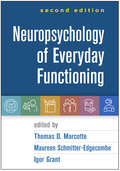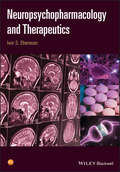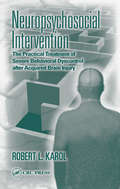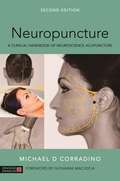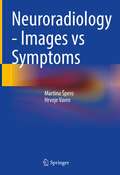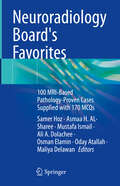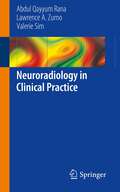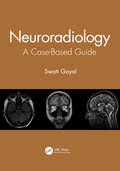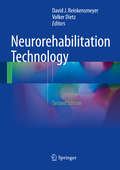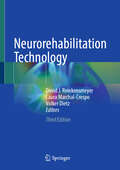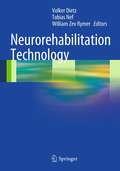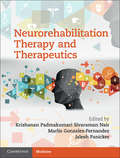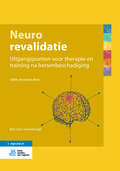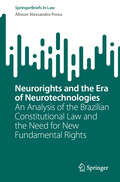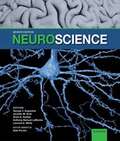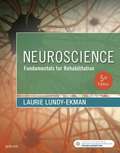- Table View
- List View
Neuropsychology of Everyday Functioning, Second Edition
by Igor Grant Thomas D. Marcotte Maureen Schmitter-EdgecombeThe go-to resource for assessing and predicting functional abilities in persons with brain injury or cognitive decline has now been revised and expanded to reflect significant advances in the field. With a focus on key real-world capacities--independent living, vocational functioning, medication management, and driving--leading experts explore how individuals go about their daily lives, where and why disruptions occur, and potential opportunities for improving function. Strategies for direct assessment are reviewed, from standard neuropsychological tests to multimodal approaches and technology-based tools. Chapters also provide functional assessment guidance for specific neurological and psychiatric conditions: dementia, traumatic brain injury, depression, schizophrenia, and others. New to This Edition *Incorporates over a decade of technological and methodological innovations. *Chapter on theories and models of everyday functioning. *Chapters on naturalistic assessment, wearable sensors, ambulatory assessment, and virtual-reality-based tools. *Practical clinical implications are highlighted throughout.
Neuropsychopharmacology and Therapeutics
by Ivor EbenezerNeuropsychopharmacology is a relatively new subject area in the neurosciences. It is a field of study that describes the effects of drugs from the molecular to the behavioural level and requires integration and synthesis of knowledge from various disciplines including neuroanatomy, physiology, molecular biology, pharmacology and the behavioural sciences. The principal aims of this book are to provide students with a clear understanding of CNS disorders, and an appreciation of how basic and clinical research findings can be translated into therapeutics. After an introduction to the subject area, the remaining chapters are focused on reviewing the main psychiatric and neurological disorders that are covered in most courses. They are discussed in terms of their clinical symptoms, epidemiology, pathology, aetiology, underlying neurobiological and neurochemical mechanisms, pharmacotherapy, adjunctive non-pharmacological treatments, and clinical outcomes. Each chapter of the book is a 'stand-alone' chapter and is written in a clear, accessible style. Written by an author with many years teaching and research experience, this textbook will prove invaluable for students of pharmacology, pharmacy and the medical sciences needing a truly integrated introduction to this exciting field.
Neuropsychosocial Intervention: The Practical Treatment of Severe Behavioral Dyscontrol After Acquired Brain Injury
by Robert L. KarolNeuropsychosocial intervention is an innovative and clinically proven treatment approach to severe behavioral problems that can affect persons with acquired brain injury. This book outlines the nature and significance of behavioral dyscontrol, explains aggression, and details the neuropsychosocial treatment approach and the principles on which it i
Neuropuncture: A Clinical Handbook of Neuroscience Acupuncture, Second Edition
by Giovanni Maciocia Michael CorradinoNeuropuncture is the clinical manual of a groundbreaking acupuncture system that incorporates neuroscience into its clinical applications for pain management, orthopaedic conditions and internal medicine. It shows acupuncturists how to apply research into the neurophysiological mechanisms of acupuncture and electrical acupuncture to the traditional TCM model of healthcare. The book explains how acupuncture works using Western medical science and illustrates how to apply this knowledge to clinical cases with electrical acupuncture, creating evidence-based acupuncture protocols. These protocols are clinically proven and result in reproducible clinical outcomes.
Neuroradiological Imaging of Skin Diseases and Related Conditions
by Daniel Thomas GinatThis unique book, written by acknowledged experts, provides a comprehensive review of the wide spectrum of skin diseases that may affect the head and neck region and central nervous system. The clearly written, informative text is accompanied by abundant examples of radiological imaging and corresponding vivid clinical photographs. Coverage includes congenital skin lesions, neurocutaneous syndromes, benign and malignant skin tumors, vascular malformations and lesions, trauma, infectious and inflammatory processes, and post-treatment appearances. The book will be an invaluable clinical resource for both neuroradiologists and dermatologists. Patients with skin diseases often undergo neuroradiological imaging, and it is therefore important for neuroradiologists to be familiar with the various types of dermatological conditions and their imaging appearances.
Neuroradiology - Expect the Unexpected
by Martina Špero Hrvoje VavroThis book presents a selection of unusual neuroradiology cases, each documented with a short medical history, CT and MRI images, and one page with clinical features and radiological findings. A total of 25 rare and peculiar cases were selected from the authors’ clinical experience. Over time, the authors witnessed several of these cases – for which there is little or no information in the international literature – being misinterpreted, especially by residents, general radiologists who occasionally have to deal with neuroradiology cases, or young neuroradiologists. Written by experienced practitioners, this atlas, with its thoroughly documented collection of rare neuroradiological cases, represents a valuable clinical tool for young radiologists and will encourage them to “think outside the box” and successfully find the correct diagnosis.
Neuroradiology - Images vs Symptoms
by Martina Špero Hrvoje VavroThe aim of this book is to emphasize firstly that rare and serious conditions can be hidden behind common (mis)leading neurological symptoms. Secondly, it stresses the importance of the collaboration with clinician colleagues - a neuroradiologist needs complete and accurate patient information to make a proper diagnosis or a differential diagnosis that can properly guide further diagnostic processing. The book, structured as an atlas, is divided into three sections according to the most common leading symptoms encountered in hospital emergency units or in outpatient settings. Each proposed case is accompanied by a short medical history, CT and MRI images, and a text describing its most important radiological features. 27 cases were chosen from the authors’ everyday practice: rare and peculiar cases, as well as common cases with a twist. Although both authors are experienced neuroradiologists, several of the cases were surprising and it took considerable time to arrive at the correct diagnosis. A certain level of knowledge and experience, together with information from literature, the Internet or from clinicians, helped them solve most of the cases directly, or after consultation with clinicians and further medical examinations and interventions. This book is mainly intended for residents, general radiologists and neuroradiologists. However, it will also be of help to less experienced colleagues or trainees who need to solve particular cases, encouraging them to think outside the box to find the answers.
Neuroradiology Board's Favorites: 100 MRI-Based Pathology-Proven Cases Supplied with 170 MCQs
by Ali A. Dolachee Mustafa Ismail Oday Atallah Maliya Delawan Samer Hoz Asmaa H. AL-Sharee Osman ElaminThe Neuroradiology Board’s Favorites is a case-based review book focused on the imaging of pathology-proven lesions related to the central nervous system.The mission of this book is to help readers revise the core concepts and maintain knowledge of neuroradiology from radiology, neurology, and neurosurgical perspectives. This study companion features a unique design and is structured in two sections, totalling 15 chapters. It includes 100 clinical scenarios and imaging, supplemented by more than 170 multiple-choice questions in a convenient format suitable for self-study. The questions are attached to each case scenario in a style that mirrors the format adopted by the majority of local, regional, and international board examinations. The answers and explanations appear immediately below the questions to enhance readability. The content of this book is an adjunct to existing texts and does not intend to be the primary source of information; it aims to help readers identify their relevant strengths and weaknesses in the area and is based on the most up-to-date best practice evidence. This book is targeted at students of radiology, neurology, neurosurgery, and neurosciences. In addition, it can be beneficial for residents, fellows, and young attendings to prepare for exams or practice.
Neuroradiology in Clinical Practice
by Abdul Qayyum Rana Lawrence A. Zumo Valerie SimThis quick reference guide for medical students and residents presents over sixty clinical case studies of major neurological conditions and their associated neuroimaging characteristics. A primer on the fundamental physics which underlie neuroimaging techniques is also provided. The content is organized by pathology type and the structure of every topic is similar to help the reader develop his or her thinking process in a stepwise fashion and to provide a rational approach to imaging interpretation. Neuroradiology in Clinical Practice is aimed at medical students and residents doing their rotations in neurology, internal medicine, emergency medicine, and family medicine, but will also be useful for allied health professionals, nurse practitioners, physician assistants and other primary medical care providers.
Neuroradiology of Brain Tumors: Practical Guide based on the 5th Edition of WHO Classification
by Fabio Maria TriulziWhile several books describing imaging of brain tumors from MR acquisition techniques to differential diagnosis are written by different contributors and present chapters with different styles and design, this book illustrates a unique vision and structure putting together modern molecular classification of brain tumor with modern neuroradiology. After an introduction on general imaging features of brain tumors the book explores each different tumor according to 2021 WHO classification, distinguishing however between adult and pediatric tumors, being the epidemiology substantially different between these two groups. The approach is schematic with few essential information on epidemiology, genetics, clinical features, location and prognosis, followed by a detailed description of imaging features with a large number of examples. Figures are mainly put together with the same modality considering all the different MR techniques as well as CT when it can be useful. Each figure provides T1, T2, FLAIR, DWI, ADC, perfusion imaging techniques, spectroscopy and post contrast study. Some examples of Amide Proton Transfer (APT) technique are provided as well. At the end of each chapter a scheme summarizes the different appearance of the tumor in any different sequence. This book will be an invaluable tool for neuroradiologists, radiologists, neurosurgeons, neurologists, pediatricians, and pathologists.
Neuroradiology: A Case-Based Guide
by Swati GoyalThis book covers the complete gamut of neuroradiology cases, including normal anatomy, pitfalls, and artifacts across the brain and spine in a single volume, enriched with high-resolution images that support the interpretation of CT and MRI images of the brain, spine, head, and neck. It includes case studies commonly encountered in clinical practice, in addition to normal anatomy, that prepare the reader for the challenges in the clinical setting. Each case study discusses the clinical history, relevant imaging findings, differential diagnosis, and management, serving as a helpful read for trainee radiologists, neurophysicians, neurosurgeons, and CT/MRI technicians, along with physicians interested in medical imaging. Key Features Provides a succinct overview of normal variants with case studies structured into thematic chapters Serves as a basic accompaniment for radiology residents, fellows, practicing radiologists, neurophysicians, neurosurgeons, emergency medicine practitioners, trainee and practicing radiographers, and those studying for Board exams Highlights the relevance of artificial intelligence in clinical practice
Neuroradiology: A Core Review
by Prachi Dubey Sathish Kumar Dundamadappa Daniel Ginat Rafeeque Bhadelia Gul MoonisDesigned specifically for the Core Exam, Neuroradiology: A Core Review covers all key aspects of neuroradiology, mimicking the image-rich, multiple-choice format of the actual test. Ideal for residents preparing for the Core Examination, as well as practitioners taking recertification exams, this unique review follows the structure and content of what you’ll encounter on the test, effectively preparing you for Core Exam success!
Neuroradiology: A Core Review (A Core Review)
by Prachi Dubey Sathish Kumar Dundamadappa Gul Moonis Daniel Thomas GinetPrepare for success on the neuroimaging component of the radiology Core Exam! Neuroradiology: A Core Review, 2nd Edition, by Drs. Sathish Kumar Dundamadappa, Prachi Dubey, Daniel Thomas Ginat, and Gul Moonis, is an up-to-date, practical review tool written specifically for the Core Exam. This helpful resource contains 500 image-rich, multiple-choice questions with detailed explanations and annotated images of right and wrong answers, fully revised content, high-yield tables for easy review, and additional eBook questions to ensure you’re ready for the Core Exam or recertification exam.
Neurorehabilitation Technology
by Volker Dietz David J. ReinkensmeyerThisrevised, updated second edition provides an accessible, practical overview ofmajor areas of technical development and clinical application in the field ofneurorehabilitation movement therapy. The initial section provides a rationalefor technology application in movement therapy by summarizing recent findingsin neuroplasticity and motor learning. The following section thenexplains the state of the art in human-machine interaction requirements forclinical rehabilitation practice. Subsequent sections describe the ongoingrevolution in robotic therapy for upper extremity movement and for walking, andthen describe other emerging technologies including electrical stimulation,virtual reality, wearable sensors, and brain-computer interfaces. The promisesand limitations of these technologies in neurorehabilitation are discussed. Throughout the book the chapters provide detailed practical information onstate-of-the-art clinical applications of these devices following stroke,spinal cord injury, and other neurologic disorders. The text is illustratedthroughout with photographs and schematic diagrams which serve to clarify theinformation for the reader. NeurorehabilitationTechnology, Second Edition is a valuableresource for neurologists, biomedical engineers, roboticists, rehabilitationspecialists, physiotherapists, occupational therapists and those training inthese fields.
Neurorehabilitation Technology
by Volker Dietz David J. Reinkensmeyer Laura Marchal-CrespoThis revised, updated, and substantially expanded third edition provides an accessible, practical overview of major areas of research, technical development and clinical application in the field of neurorehabilitation movement therapy. The initial section provides the basic framework and a rationale for technology application in movement therapy by summarizing recent findings in neuroplasticity and motor learning. The following section provides a detailed overview of the movement physiology of various neurologic conditions, illustrating how this knowledge has been used to design various neurorehabilitation technologies. The third section then explains the principles of human-machine interaction for movement rehabilitation. The fourth section provides an overview of assessment technology and predictive modeling in neurorehabilitation. The fifth section provides a survey of technological approaches to neurorehabilitation, including spinal cord stimulation, functional electrical stimulation, virtual reality, wearable sensing, brain computer interfaces, mobile technologies, and telerehabilitation. The final two sections examine in greater detail the ongoing revolution in robotic therapy for upper extremity movement and walking, respectively. The promises and limitations of these technologies in neurorehabilitation are discussed, including an Epilogue which debates the impact and utility of robotics for neurorehabilitation. Throughout the book the chapters provide detailed practical information on state-of-the-art clinical applications of these devices following stroke, spinal cord injury, and other neurologic disorders and future developments in the field. The text is illustrated throughout with photographs and schematic diagrams which serve to clarify the information for the reader.Neurorehabilitation Technology, Third Edition is a valuable resource for neurologists, biomedical engineers, roboticists, rehabilitation specialists, physiotherapists, occupational therapists and those training in these fields.
Neurorehabilitation Technology
by Tobias Nef Volker Dietz William Zev RymerNeurorehabilitation Technology provides an accessible, practical overview of the all the major areas of development and application in the field. The initial chapters provide a clear, concise explanation of the rationale for robot use and the science behind the technology before proceeding to outline a theoretical framework for robotics in neurorehabilitative therapy. Subsequent chapters provide detailed practical information on state-of-the-art clinical applications of robotic devices, including robotics for locomotion; posture and balance and upper extremity recovery in stroke and spinal cord injury. Schematic diagrams, photographs and tables will be included to clarify the information for the reader. The book also discusses standard and safety issues and future perspectives.
Neurorehabilitation Therapy and Therapeutics
by Jalesh N. Panicker Krishanan Padmakumari Nair Marlís González-FernándezCognitive impairment, dysphagia, communication issues, pain, spasticity, bladder dysfunction, sexual dysfunction and bowel incontinence are but a few problems frequently reported by individuals living with long-term neurological conditions. The management of long-term neurological conditions requires co-ordinated inputs from multiple disciplines, and this practical handbook facilitates this by combining physical, cognitive and psychological strategies to patient management. Featuring contributions from leading experts in neurology, health services and clinical rehabilitation, this book is a comprehensive overview of common neurological impairments and solutions. It adopts an evidence-based approach to both pharmacological and non-pharmacological options for alleviating neurological symptoms. An easy-to-refer to guide, bridging multiple disciplines, aided by current research, to provide effective, and practical management for all aspects and issues arising in the rehabilitation phases of the neurological patient. This unique pocketbook is intended for practitioners at all levels; ideally suited as a quick guide during ward rounds, out-patient clinics and therapy sessions.
Neurorehabilitation of the Upper Limb Across the Lifespan
by Jodie Copley Kathy KuipersA comprehensive guide to managing spastic hypertonia after brain injury and the first full overview of this areaThe ideal reference for therapeutic interventions that optimise arm and hand function to support goal achievementAn extensive clinical manual for neurological practice, a key reference for students and qualified practitioners, and a valuable resource for all occupational therapists and physiotherapists working with brain-injured clients
Neurorevalidatie: Uitgangspunten voor therapie en training na hersenbeschadiging
by Ben van CranenburghDit boek bespreekt het brede gedachtegoed van de neurorevalidatie op basis waarvan patiënten met een hersenaandoening een weloverwogen behandeling en begeleiding geboden kan worden. Het behandelt de biologische en leertheoretische grondslagen, biedt een praktische uitwerking van de theorie en laat nieuwe perspectieven uit wetenschappelijk onderzoek zien. Het boek is bedoeld voor medici, paramedici, psychologen en verpleegkundigen. Neurorevalidatie, uitgangspunten voor therapie en training na hersenbeschadiging maakt deel uit van de zesdelige serie ‘Toegepaste neurowetenschappen’. Het boek gaat over herstel na hersenbeschadiging en de mogelijkheden dit door therapie of training te beïnvloeden. Ongenuanceerde opvattingen als ‘Eenmaal laesie, altijd gestoord’ en ‘Na zes maanden is geen verder herstel meer te verwachten’, worden ontzenuwd en vervangen door realistische informatie. Doemdenken en therapeutisch nihilisme zijn verleden tijd. Nieuwe inzichten in de plasticiteit van de hersenen en in uiteenlopende mechanismen van herstel, rechtvaardigen een positief denkklimaat. Deze vijfde editie is geheel geactualiseerd; de verschillende leerstrategieën die bij de neurorevalidatie kunnen worden ingezet zijn gebundeld in een apart hoofdstuk. Het boek is opgebouwd uit drie delen. Eerst wordt de biologische basis besproken. U leest over belangrijke neurowetenschappelijke concepten, plasticiteit, het herstelvermogen en enkele praktijkvoorbeelden van opmerkelijk herstel. Het tweede deel gaat over de leertheoretische basis: de principes van leren en het geheugen, het leren van motorische vaardigheden en het leren en afleren van gedrag. Revalidatie = leren! In het laatste deel wordt de praktische uitwerking besproken. Het geeft antwoord op de vraag: welke therapeutische interventie gebruik je waarom, wanneer en bij wie? De systematiek van de empirische cyclus is de leidraad bij individueel toegesneden probleemanalyse en behandelprogramma. Aan de hand van vele voorbeelden op het gebied van motoriek, cognitie en gedrag worden de probleemanalyse en interventiestrategieën praktisch uitgewerkt. Recent wetenschappelijk onderzoek naar het effect van specifieke therapieën en leerstrategieën levert onvermoede perspectieven voor de patiënt met hersenbeschadiging. Het boek is ook digitaal beschikbaar met deeplinks naar casuïstiek en YouTube-video’s, vragen en antwoorden en samenvattingen. Neurowetenschapper Ben van Cranenburgh studeerde geneeskunde in Amsterdam en was als wetenschappelijk medewerker verbonden aan onder meer het Nederlands Centraal Instituut voor Hersenonderzoek en het Revalidatie Centrum Amsterdam. In 1987 richtte hij het Instituut voor toegepaste neurowetenschappen (stichting ITON) op, waarvan hij tot op heden directeur is. De stichting ITON biedt nascholingscursussen aan op het gebied van de toegepaste Neurowetenschappen.
Neurorheumatology: A Comprehenisve Guide to Immune Mediated Disorders of the Nervous System
by Tracey A. Cho Shamik Bhattacharyya Simon HelfgottThis detailed, practical textbook focuses on immune mediated disorders of the nervous system with particular focus on systemic autoimmune disorders. Divided into three sections, the first discusses the neuroanatomical and pathophysiologic basis of immune mediated disorders of the nervous system. Following this are 25 chapters devoted to individual clinical conditions. To conclude, the final section explains what is known about the mechanisms of immunomodulatory treatments and practical points about monitoring patients on these treatments. Neurorheumatology: A Comprehensive Guide to Immune Mediated Disorders of the Nervous System bridges the gaps among different branches of medicine and is an indispensable resource for rheumatologists and neurologists looking to develop a firm understanding of these dynamic disorders
Neurorights and the Era of Neurotechnologies: An Analysis of the Brazilian Constitutional Law and the Need for New Fundamental Rights (SpringerBriefs in Law)
by Alisson Alexsandro PossaThis book provides an in-depth study on the theory of fundamental rights and the legal challenges posed by new technologies, with a particular focus on neurotechnologies and neurorights. The book begins with an overview of the evolution of neuroscience and neurotechnology, highlighting the current challenges these advancements pose to contemporary legal frameworks. It also discusses the potential for widespread adoption of these technologies, driven by significant investments from tech companies. The first chapter delves into the development of neuroscience and neurotechnology, emphasizing the legal implications and future concerns associated with their mass adoption. It explores how these technologies are being integrated into society and the legal challenges they present. The second chapter examines the concept of neurorights, identifying the legal objects these rights aim to protect and the new risks introduced by neurotechnologies. It provides a comprehensive review of the main neurorights proposals from recent decades, with a detailed analysis of the theoretical framework proposed by Marcello Ienca and Roberto Andorno in 2017. Their proposal includes four new human rights: cognitive freedom, mental privacy, mental integrity, and psychological continuity. The final chapter analyzes the relationship between neurorights and existing constitutional protections, focusing on the protection of human dignity. It discusses the right to free development of personality, physical and psychological integrity, and privacy and data protection. The chapter draws on theories of fundamental rights from Brazilian constitutionalists to provide a thorough examination of these issues. The book offers a broad analysis of the main neurorights proposals by international researchers, comparing them with the fundamental rights recognized in the Brazilian Constitution. It aims to determine whether new fundamental rights are necessary to protect Brazilian citizens from the potential harms of neurotechnology. This study is essential for researchers in neuroethics, neurorights, and fundamental rights, providing valuable insights into the intersection of law and emerging technologies.
Neuroscience
by Scott A. Huettel Jennifer M. Groh George J. Augustine Anthony-Samuel LaMantia Leonard E. White and Emeritus Editor Dale PurvesFor more than twenty-five years, Neuroscience has been the most comprehensive and clearly written neuroscience textbook on the market. This level of excellence continues in the seventh edition, with a balance of animal, human, and clinical studies that discuss the dynamic field of neuroscience from cellular signaling to cognitive function. New learning objectives and more concise sections make the content even more accessible than before. Neuroscience provides a bridge between the undergraduate and medical school worlds. It brings the relevance of neuroscience to both those exploring careers in the field as undergraduates and those developing core neuroscience understanding for medical school. It accomplishes this by presenting a balance of animal, human, and clinical studies that discuss the dynamic field of neuroscience from cellular signaling to cognitive function.
Neuroscience (Fifth Edition): Fundamentals For Rehabilitation
by Laurie Lundy-EkmanBoost your skills in planning and managing physical rehabilitation! Neuroscience: Fundamentals for Rehabilitation, 5th Edition provides a practical guide to the nervous system and how it affects the practice of physical and occupational therapy. Case studies and first-person stories from people with neurologic disorders make it easier to apply your knowledge to the clinical setting. New to this edition are new chapters on neuroanatomy imaging and neurologic examination techniques. Written by noted PT educator Laurie Lundy-Ekman, this book uses evidence-based research to help you understand neurologic disorders and treat clients who have physical limitations due to nervous system damage or disease.
Neuroscience For Dummies
by Frank AmthorGet on the fast track to understanding neuroscience Investigating how your senses work, how you move, and how you think and feel, Neuroscience For Dummies, 2nd Edition is your straight-forward guide to the most complicated structure known in the universe: the brain. Covering the most recent scientific discoveries and complemented with helpful diagrams and engaging anecdotes that help bring the information to life, this updated edition offers a compelling and plain-English look at how the brain and nervous system function. Simply put, the human brain is an endlessly fascinating subject: it holds the secrets to your personality, use of language, memories, and the way your body operates. In just the past few years alone, exciting new technologies and an explosion of knowledge have transformed the field of neuroscience--and this friendly guide is here to serve as your roadmap to the latest findings and research. Packed with new content on genetics and epigenetics and increased coverage of hippocampus and depression, this new edition of Neuroscience For Dummies is an eye-opening and fascinating read for readers of all walks of life. Covers how gender affects brain function Illustrates why some people are more sensitive to pain than others Explains what constitutes intelligence and its different levels Offers guidance on improving your learning What is the biological basis of consciousness? How are mental illnesses related to changes in brain function? Find the answers to these and countless other questions in Neuroscience For Dummies, 2nd Edition
Neuroscience For Dummies
by Frank AmthorA fascinating look at what’s rattling around in your skull Neuroscience For Dummies introduces you to the mind-boggling study of the human brain. It tracks to the content of a typical introductory neuroscience class at the college level —and it’s perfect for anyone curious about what makes us tick. New technologies and an explosion of research have completely transformed our understanding of memory, depression, the mind-body connection, learning, and genetics. This updated edition—still in classic, beginner-friendly Dummies style—covers the latest research advances and technologies in the field of neuroscience. Put some knowledge about the brain into your brain. Grasp the basic concepts and applications of neuroscience Understand the brain’s structure and function Explore how the brain impacts memory, learning, and emotions Discover how the brain is connected with other physical systemsFor students and general readers alike, Neuroscience For Dummies is a great way to understand what’s going on inside our heads.
